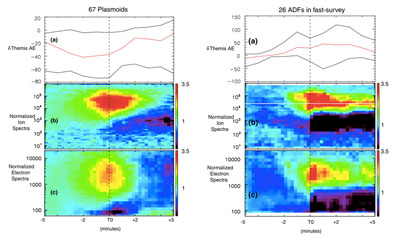2014 ARTEMIS SCIENCE NUGGETS
Antidipolarization fronts observed by ARTEMIS
by Shanshan Li, UCLA EPSS & IGPP
Introduction
A plasmoid is usually described as a plasma sheet expansion into the lobe, encompassed by closed magnetic loops or the helical fields of a flux rope.
Studies on the earthward side of the NENL reconnection site (in the near-Earth tail), however, reveal that many earthward moving "plasmoids" are actually dipolarization fronts (DFs). In a DF observation there is usually a small decrease in Bz before the Bz enhancement, which is similar to the south-north bipolar Bz signature in a plasmoid observation. Unlike the Bz decrease associated with the core current structure of an earthward moving plasmoid, the Bz decrease associated with a DF likely results from a dawnward current ahead of the front. Moreover, unlike a plasmoid, a DF separates two distinct plasma populations: dense, cold, compressed ambient plasma ahead of the front and dilute, energetic plasma with a strong magnetic field behind it.
Recently, sharp, highly asymmetric north-then-south bipolar variations (with a larger southward portion) in the magnetic field Bz component have been noted in midtail (XGSM ~60 RE) plasmoids [Li et al., 2014a]. These variations do not fit the classical plasmoid model but are mirror images of earthward moving dipolarization fronts (DFs). We use three years of ARTEMIS observations to study these typically tailward-moving fronts, which we refer to as "antidipolarization fronts" (ADFs).
Observations
Figure 1 shows a typical ADF observation at 0422 UT (particle distributions of this event are also presented in the paper): (1) The sharp decrease in magnetic field Bz component. (2) A gradual increase in tailward flow spead starts ~1 minute prior to the front arrival. (3) Two populations are separated by the ADF.
| Figure 1. |
Figure 2 shows the superposed epoch analysis of ADFs. Besides the velocity and magnetic fields, other ADF observations also show variations similar to DFs: ADFs exhibit a sharp density decrease, plasma pressure increase, magnetic pressure increase, and particle heating immediately following the sharp Bz change.
| Figure 2. |
Figure 3 shows the superposed normalized energy spectrograms of plasmoids (left) and ADFs(right).
| Figure 3. |
Conclusion
Antidipolarization fronts are different from plasmoids: (1) Their magnetic field bipolar signature is highly asymmetric compared to plasmoids. It is more appropriate to describe the magnetic field variation as a small BZ increase followed by a sudden, sharp decrease in Bz. (2) The population following an ADF is distinctly different (more energetic, hot, and tenuous) from the one ahead of an ADF.
As indicated from MHD simulations, an ADF can be produced by a single pulse of fast reconnection, and it is not necessarily a closed loop/flux rope structure, unless plasma sheet field lines were involved in the reconnection process. This is different from the mechanism of plasmoid formation, in which two X lines are required.
The magnetic field and plasma properties of ADFs are almost the same as those of DFs in the near-Earth tail, which support the idea that near-Earth reconnection could generate reconnection fronts moving in opposite directions.
Reference
Li, S.S., J. Liu, V. Angelopoulos, A. Runov, S. A. Kiehas (2014), Anti-Dipolarization Fronts Observed by ARTEMIS, J. Geophys. Res. Space Physics, 119, 7181–7198, doi:10.1002/2014JA020062.Biographical Note
Shanshan Li is a graduate student in the Experimental Space Physics Group at UCLA, under Professor Vassilis Angelopoulos. Her research interests focus on phenomena in the Earth’s magnetosphere, especially in the magnetotail. She analyzes data collected by the THEMIS/ARTEMIS spacecraft and performs both case study and statistical analyses. By studying the the dipolarization fronts (DFs) and the plasmoids with multi-point observations, her work aims to test and refine the substorm model in three-dimensional space.
 Please send comments/suggestions to
Emmanuel Masongsong / emasongsong@igpp.ucla.edu
Please send comments/suggestions to
Emmanuel Masongsong / emasongsong@igpp.ucla.edu


